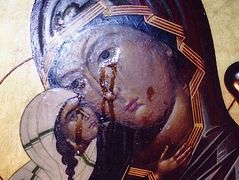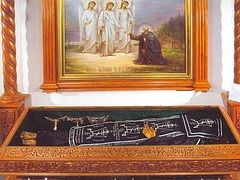Andrei Muzolph, teacher at the Kiev Theological Seminary, speaks on miraculous icons, incorrupt relics, myrrh-streaming relics, holy springs, holy oil and other Orthodox sacred objects.
—Andrei, are there many wonderworking icons in the Church? Is such a designation appropriate? And how can we explain it?
—To answer your question, we first need to define what is an icon. An icon is a window into the heavenly realm. They’re important for believers because they depict the Kingdom of God, come with power (Mk. 9:1), because besides God and the angels, icons depict the saints as well—that is, those people who pleased God by their podvigs. The saints are people just like we are; the only thing that distinguishes them from us is that they have already attained to that for which we are yet striving, and which is the main purpose for the life of every man—theosis. Therefore, icons serve to remind man about the necessity of striving for God, to that Archetype, according to Which we all were created, but Which we later eclipsed by our sins.
Regarding the miraculous nature of certain icons, it should be clarified that no icon is miraculous in and of itself. There is only one source of miracles in this world—the Lord, Who by His ineffable love sends us His mercy and grace. Thus, St. Theophan the Recluse writes: “Some icons are miraculous because it so pleases God, but the power is not in the icons, or in the people turning to them, but in the mercy of God.” A miracle is precisely a manifestation of God’s mercy towards us sinful people. The Lord creates miracles anywhere, anytime, and through anything. But in the thoughts of the holy fathers, because the grace of God is most often manifested in response to prayer, in response to our turning to our Creator, then miracles, accordingly, most often happen in those places where there is such prayer; that is, in churches: during the services, in the Mysteries of the Church, and before holy icons, relics, etc.
During prayer we open our hearts before God, and in response the Lord sends us His saving grace, healing and transfiguring us internally. God alone, and no one else, is the source of this grace, however, as man is a creature both spiritual and bodily, grace reveals itself also through visible, physical realities: icons, relics, holy water. Orthodoxy, as opposed to dualistic concepts, never considered matter evil. God created everything “very good,” and therefore, according to the holy apostle Paul, not only men will attain theosis, but creation itself in the end will be freed from the power of corruption (Rom. 8:21). Christianity doesn’t call man, like many religio-philosophical systems, to wholly detach from matter, but quite the contrary—it uses matter in the work of man’s salvation. God saves man as a material creation, not without participation in this matter.
That’s why we can say that every icon is miraculous, above all witnessing to the true miracle—the miracle of the possibility of man communing with God.
—One of the most amazing Orthodox miracles is the incorrupt relics of the saints. What are holy relics? When did the veneration of icons arise? Do we know whose relics were the first to be venerated?
—As was already said above, Christianity highly values human nature. Clear proof of this is the tradition of venerating the relics of saints. The holy fathers point out that the main reason for the veneration of relics in the Church of Christ is the Incarnation. The Son of God, having assumed human nature in all its fullness in the Incarnation, excluding sin, shows thereby its importance and dignity. The holy apostle Paul calls upon Christians to glorify God not only in soul, but in our bodies, which are also God’s creation and the temple of the Holy Spirit (cf. 1 Cor. 6:19-20), and therefore even death is incapable of depriving man of this prerogative.
St. John of Damascus, speaking about the veneration of holy relics, writes, “The Lord Christ gave us saving sources: the relics of saints, pouring out diverse blessings, exuding the sweet smell of myrrh… Under the Law, anyone coming into contact with the dead becomes unclean (cf. Num. 19:11); but they are not dead. For since that time that He Who is life itself, the Reason for life, was numbered among the dead, we don’t call dead those who have reposed in the hope of resurrection and with faith in Him… Through relics demons are repelled, the infirm are healed, the blind see the light, lepers are cleansed, temptations and woes cease, and every good and perfect gift descends from above, from the Father of lights (Jas. 1:17) through them for those who ask with undoubting faith.”
Regarding the practice of venerating relics, we should note that in the Old Testament there is already mention of the miraculous remains of departed saints. 4 Kings speaks about how touching the bones of the prophet Elisha revived the dead (cf. 4 Kg. 13:21).
Additionally, we see in the Gospels an indication of the post-mortem veneration of the bodies (relics) of the saints: after Herod beheaded the holy prophet and Forerunner of the Lord John, the disciples of the prophet took his body and reverently buried it. Such was also done with the body of the first Christian martyr, the holy archdeacon Stephen.
We also know from Church history that the first ancient evidence of the veneration of the relics of saints dates to the middle of the second century, taken from the life of Hieromartyr Polycarp of Smyrna. His life says that after the hieromartyr was burned at the stake, the Christians of Smyrna lovingly gathered his remains and kept them “in a fitting place.”
—What are myrrh-streaming relics? How are they stored? Where are the most famous ones?
—Myrrh-streaming relics are holy relics whose holiness is moreso confirmed by external manifestations—streams of myrrh. So, periodically a special viscous liquid, myrrh, emanates from them, possessing a powerful, pleasant odor.
The most famous myrrh-streaming relics are in the Far Caves of the Kiev Caves Lavra, belonging to unknown God-pleasers. The origin of only one of them is reliably known—the hieromartyr Clement, Pope of Rome, who suffered at the beginning of the second century in Chersonesus (now a district of Sevastopol). In either 988 or 989 a piece of his relics was translated by the order of Equal-to-the-Apostles Prince Vladimir to Kiev and subsequently ended up in the Caves Lavra.
—Orthodox pilgrimage routes often point out various holy springs. What is significant about them? What kind of water is in them? How should we use it?
—Holy water from a spring and holy water blessed in church, for example on Theophany, despite the opinion of many, are not the same thing.
We call water from a spring “holy” not because it’s blessed in the well, but because of its unusual, miraculous origin. We know from Church history that in places of special appearances of God or the Theotokos or some saints, springs miraculously appeared. Using this water with reverence, and also with faith and hope in God, many having problems with health received healing of their infirmities. Therefore, such water is known as “holy” or “healing” among the people, because, taken with prayer, it brings benefit to the human body.
However, water that is blessed in either the Great or Lesser Blessing of Waters is more correctly called “holy.” The latter is called in the liturgical tradition “agiasma,” meaning “holy.” At the moment of its blessing, holy water becomes, as Fr. Alexander Schmemann says, that which all material was designed to be—a means to the ultimate goal, the deification of man, knowledge of God, and union with Him.
According to St. Dimitry of Rostov, holy water has the power to consecrate both the human soul and body—the sole necessary condition for this is the faith of the person himself. St. Theophan the Recluse says it is nonsensical to rely on the healing power of holy water if in your heart there is no true faith in God.
And elsewhere the saint writes that the grace coming from God through the holy Cross, holy icons, holy water, relics, and even Communion itself, has power only for those who are worthy of this grace through repentance, humility, service to others, acts of charity and the manifestation of other Christian virtues. But without them grace does not save. It does not act automatically, like a talisman, but is useless for the impious, or Christians in name but without any virtue.
Thus, we can drink a hundred liters of Theophany water, but if we don’t have faith in God and love for our neighbors, this water, unfortunately, will never be the source of living water which directs us towards eternal life, as is said in the order of the Great Blessing of Waters.
—How should we relate to relics like the hat of St. Mark the Grave-Digger or the slippers of St. Spyridon of Tremithus, which are said to have special miraculous power?
—According to established pious tradition, we relate to such holy items just as we do to their holy “owners.” In a few cases, for example there are even special liturgical days devoted to the robe of the Most Holy Theotokos or the chains of St. Peter.
It says in Holy Scripture more than once that not just some God pleasers had the gift of miracles, but even pieces of their clothing had special miraculous powers: The mantle of the holy prophet Elijah divided the waters of the river (4 Kg. 2:8), and handkerchiefs and aprons of the holy apostle Paul were used to heal diseases and even drive out evil spirits (Acts. 19:12).
But we never address ourselves to such items in prayer, but only to the saints to whom they belong. We do not exclaim: “Holy hat, pray to God for us,” but we say: “O Holy Father Mark, pray to God for us.” Veneration for this or that item is based not on its autonomous holiness, but its belonging to this or that ascetic: The grace of the Holy Spirit acts so abundantly in God’s chosen ones that even their everyday items become conduits of God’s power. But, at the same time, such sacred items should not become for us paramount, overshadowing God Himself, the Giver of miracles. Otherwise such perverted spiritual practice will lead us to dependence on relics, and our lives will become a search for specific relics, while the main thing—striving for repentance and communion of the Body and Blood of the Lord—becomes something unimportant and trivial. Thus, ever more justified are the words of one modern theologian who notes a quite widespread tendency today: “Pilgrims go to monasteries not for Communion, but for ‘sand from the graves.’” But this, quite unfortunately, is nothing other than a sign of a man’s spiritual illness.
—And what is blessed oil? How should we properly use it?
—Originally blessed oil was used exclusively in the services. Here is the history of this practice: at Matins for major feasts, during the Polyeleos, the priest would take oil from the lampada in front of the icon of the feast or saint and anoint the worshipers with it, symbolically signifying the participation of the faithful in the joy of the event being celebrated. We do not find either in Patristic or liturgical texts that this oil has any special healing properties.
However, at the same time, oil itself has always been considered a healing substance. Even in the Old Testament oil symbolized the goodness of God towards man, and joy and revitalization. And in the Gospels it says the holy apostles used oil for anointing the sick, who were thereby healed (cf. Mk. 6:13). St. Symeon of Thessaloniki writes: “Oil is holy by the power of the rites and filled with Divine strength, and moreover, as it anoints the flesh it enlightens and sanctifies the soul, strengthening both the bodily and spiritual powers, healing wounds, destroying diseases, cleansing from all sinful impurities, having the strength to grant us the mercy of God and to appease Him.”
Of course, as was said above, such miraculous powers of such sacred objects, like oil, does not indicate their distinctive character or independence. Holy oil is only a symbol, a means through which God acts in our lives. And therefore, the main thing is that our pious attitude towards such sacred objects would not turn into magic or ritualism. No faith in the specific actions of certain items should overcome faith in God in our lives, and in that which He has prepared for every one of us, if only we are faithful to our call to become children of God in Christ (cf. Jn. 1:12).










